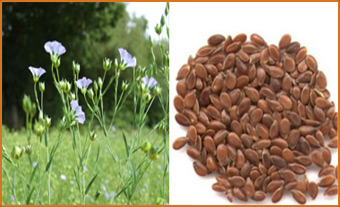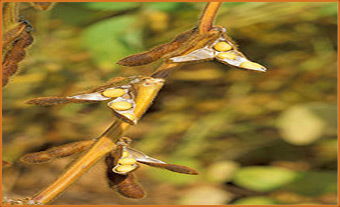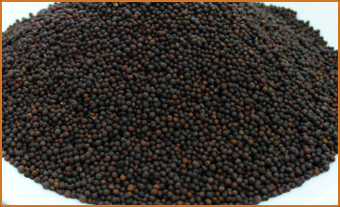Products: Agro Seeds
 It may
be tiny, but it’s mighty: The Linseed also called as flax seed carries one
of the biggest nutrient payloads on the planet. And while it’s not
technically a grain, it has a similar vitamin and mineral profile to grains,
while the amount of fiber, antioxidants, and Omega-3 fatty acids in flax
leaves grains in the dust. Additionally, flax seed is very low in
carbohydrates, making it ideal for people who limit their intake of starches
and sugars. And its combination of healthy fat and high fiber content make
it a great food for weight loss and maintenance -- many dieters have found
that flax seed has been a key to keeping them feeling satisfied.
It may
be tiny, but it’s mighty: The Linseed also called as flax seed carries one
of the biggest nutrient payloads on the planet. And while it’s not
technically a grain, it has a similar vitamin and mineral profile to grains,
while the amount of fiber, antioxidants, and Omega-3 fatty acids in flax
leaves grains in the dust. Additionally, flax seed is very low in
carbohydrates, making it ideal for people who limit their intake of starches
and sugars. And its combination of healthy fat and high fiber content make
it a great food for weight loss and maintenance -- many dieters have found
that flax seed has been a key to keeping them feeling satisfied.
Use
Flax is grown both for its seeds and for its fiber. Various parts of the plant have been used to make fabric, dye, paper, medicines, fishing nets, hair gels,cloths,ropes,high quality paper and soap. Flax seed is the source of linseed oil, which is used as an edible oil, as a nutritional supplement, and as an ingredient in many wood finishing products. Flax is also grown as an ornamental plant in gardens. The Latin species name usitatissimum means most useful, pointing to the several traditional uses of the plant and their importance for human life.Nutrients and clinical research
Flax seeds contain high levels of dietary fiber as well as lignans, an abundance of micronutrients and omega-3 fatty acids (table). Flax seeds may lower cholesterol levels, especially in women. A study done at Duke University suggests that flaxseed may stunt the growth of prostate tumors,[14] although a meta-analysis found the evidence on this point to be inconclusive.[15] Flax may also lessen the severity of diabetes by stabilizing blood-sugar levels.[16] There is some support for the use of flax seed as a laxative due to its dietary fiber content[6] though excessive consumption without liquid can result in intestinal blockage.[17] Consuming large amounts of flax seed may impair the effectiveness of certain oral medications, due to its fiber content,[17] and may have adverse effects due to its content of neurotoxic cyanogen glycosides and immunosuppressive cyclic nonapeptides.[citation neededOne of the main components of flax is lignan, which has plant estrogen as well as antioxidants (flax contains up to 800 times more lignans than other plant foods contain).
 The
soybean (U.S.) or soya bean (UK) (Glycine max) is a species of legume native
to East Asia, widely grown for its edible bean which has numerous uses. The
plant is classed as an oilseed rather than a pulse by the Food and
Agricultural Organization (FAO).
The
soybean (U.S.) or soya bean (UK) (Glycine max) is a species of legume native
to East Asia, widely grown for its edible bean which has numerous uses. The
plant is classed as an oilseed rather than a pulse by the Food and
Agricultural Organization (FAO).
Fat-free (defatted) soybean meal is a significant and cheap source of
protein for animal feeds and many prepackaged meals, soy vegetable oil is
another product of processing the soybean crop. For example, soybean
products such as textured vegetable protein (TVP) are ingredients in many
meat and dairy analogues. Soybeans produce significantly more protein per
acre than most other uses of land.
History
Soybeans were a crucial crop in eastern Asia long before written records. Prior to fermented products such as soy sauce, tempeh, natto, and miso, soy was considered sacred for its use in crop rotation as a method of fixing nitrogen. The plants would be plowed under to clear the field for food crops. Soy was first introduced to Europe in the early 18th century and to British colonies in North America in 1765, where it was first grown for hay. Benjamin Franklin wrote a letter in 1770 mentioning sending soybeans home from England. Soybeans did not become an important crop outside of Asia until about 1910. In America, soy was considered an industrial product only, and was not used as a food prior to the 1920s. Soy was introduced to Africa from China in the late 19th century, and is now widespread across the continent.Uses
Approximately 85% of the world's soybean crop is processed into soybean meal and vegetable oil.[63] Soybeans can be broadly classified as "vegetable" (garden) or field (oil) types. Vegetable types cook more easily, have a mild, nutty flavor, better texture, are larger in size, higher in protein, and lower in oil than field types. Tofu and soy milk producers prefer the higher protein cultivars bred from vegetable soybeans originally brought to the United States in the late 1930s. The "garden" cultivars are generally not suitable for mechanical combine harvesting because there is a tendency for the pods to shatter upon reaching maturity.Among the legumes, the soybean, also classed as an oilseed, is preeminent for its high (38–45%) protein content as well as its high (20%) oil content. Soybeans are the second-most valuable agricultural export in the United States behind corn. The bulk of the soybean crop is grown for oil production, with the high-protein defatted and "toasted" soy meal used as livestock feed.
 Mustard
seeds are the small round seeds of various mustard plants. The seeds are
usually about 1 or 2 mm in diameter. Mustard seeds may be colored from
yellowish white to black. They are important spices in many regional foods.
The seeds can come from three different plants: black mustard (Brassica
nigra), brown Indian mustard (B. juncea), and white mustard (B.
hirta/Sinapis alba).
Mustard
seeds are the small round seeds of various mustard plants. The seeds are
usually about 1 or 2 mm in diameter. Mustard seeds may be colored from
yellowish white to black. They are important spices in many regional foods.
The seeds can come from three different plants: black mustard (Brassica
nigra), brown Indian mustard (B. juncea), and white mustard (B.
hirta/Sinapis alba).
History
The earliest reference to mustard is in India from a story of Gautama Siddhārtha (सिद्धार्थ गौतम) in the 5th century BCE. Gautama Buddha told the story of the grieving mother (Kisa Gotami) and the mustard seed. When a mother loses her only son, she takes his body to the Buddha to find a cure. The Buddha asks her to bring a handful of mustard seeds from a family that has never lost a child, husband, parent or friend. When the mother is unable to find such a house in her village, she realizes that death is common to all, and she cannot be selfish in her grief.[1][2] The Buddha stated that if an individual were to pick a single mustard seed every hundred years from a seven-mile cube worth of mustard seeds, then by the time the last seed is picked, the age of the world cycle would still continue. (If a mustard seed is 3 mm in diameter, then taking one seed every 100 years from a seven-mile cube of seeds, would take 936 quintillion years, 68 billion times the age of the universe.)Regional usage
Aavalu (Telugu: ఆవlu), kadugu (Tamil: கடுகு), or sasive (Kannada:ಸಾಸಿವೆ), a variety of Indian pickle consisting mainly of mangoes, red chilli powder and aavaa pindi (powdered mustard seed) preserved in mustard oil, is popular in Southern India with its origin in Andhra Pradesh. These mustard seeds are known in Hindi/Urdu as sarson and in Punjabi as sarron. These are used as a spice in Northern India and Nepal. The seeds are usually roasted until they pop. They are also planted to grow saag (greens) which are stir-fried and eaten as a vegetable preparation, sarson ka saag (sarron da saag in Punjabi).Cultivation
Mustard seeds generally take three to ten days to germinate if placed under the proper conditions, which include a cold atmosphere and relatively moist soil. Mature mustard plants grow into shrubs. Mustard grows well in temperate regions. Major producers of mustard seeds include Canada, Hungary, Great Britain, India, Pakistan and the United States. Brown and black mustard seeds return higher yields than their yellow counterparts.[12] In Pakistan, rapeseed-mustard is the second most important source of oil, after cotton. It is cultivated over an area of 307,000 hectares with annual production of 233,000 tonnes and contributes about 17% to the domestic production of edible oil. Wheat is
grown on more land area than any other commercial crop and is the most
important staple food for humans. World trade in wheat is greater than for
all other crops combined.[4] Globally, wheat is the leading source of
vegetable protein in human food, having a higher protein content than either
maize (corn) or rice, the other major cereals. In terms of total production
tonnages used for food, it is currently second to rice as the main human
food crop and ahead of maize, after allowing for maize's more extensive use
in animal feeds.
Wheat was a key factor enabling the emergence of city-based societies at the
start of civilization because it was one of the first crops that could be
easily cultivated on a large scale, and had the additional advantage of
yielding a harvest that provides long-term storage of food.
Wheat is
grown on more land area than any other commercial crop and is the most
important staple food for humans. World trade in wheat is greater than for
all other crops combined.[4] Globally, wheat is the leading source of
vegetable protein in human food, having a higher protein content than either
maize (corn) or rice, the other major cereals. In terms of total production
tonnages used for food, it is currently second to rice as the main human
food crop and ahead of maize, after allowing for maize's more extensive use
in animal feeds.
Wheat was a key factor enabling the emergence of city-based societies at the
start of civilization because it was one of the first crops that could be
easily cultivated on a large scale, and had the additional advantage of
yielding a harvest that provides long-term storage of food.
Nutritional Importance of wheat
Wheat is grown on more than 240 million hectares, larger than for any other crop. World trade in wheat is greater than for all other crops combined. With rice, wheat is the world's most favored staple food. Wheat provides more nourishment for humans than any other food source. It is a major diet component because of the wheat plant’s agronomic adaptability with the ability to grow from near arctic regions to equator, from sea level to plains of Tibet (4000 meters above sea level). In addition to agronomic adaptability, wheat offers ease of grain storage and ease of converting grain into flour for making edible, palatable, interesting and satisfying foods. Wheat is the most important source of carbohydrate in a majority of countries.Wheat protein is easily digested by nearly 99% of human population (see gluten sensitivity for exception). So is its starch. Wheat also contains a diversity of minerals, vitamins and fats (lipids). With a small amount of animal or legume protein added, a wheat-based meal is highly nutritious.
The most common forms of wheat are white and red wheat. However, other natural forms of wheat exist. For example, in the highlands of Ethiopia grows purple wheat, a tetraploid species of wheat that is rich in anti-oxidants. Other commercially minor but nutritionally promising species of naturally evolved wheat species include black, yellow and blue wheat
Categories
- Lin Seeds
- Soya Bean Seeds
- Mustard Seeds
- Wheat Seeds
- Fenugreek Seeds (Methi)
- Dill Seeds (Suwa)
- Carom Seeds (Ajwain)
- Coriander Seeds (Dhaniya)
- Nigella Sativa (Kalonji)

